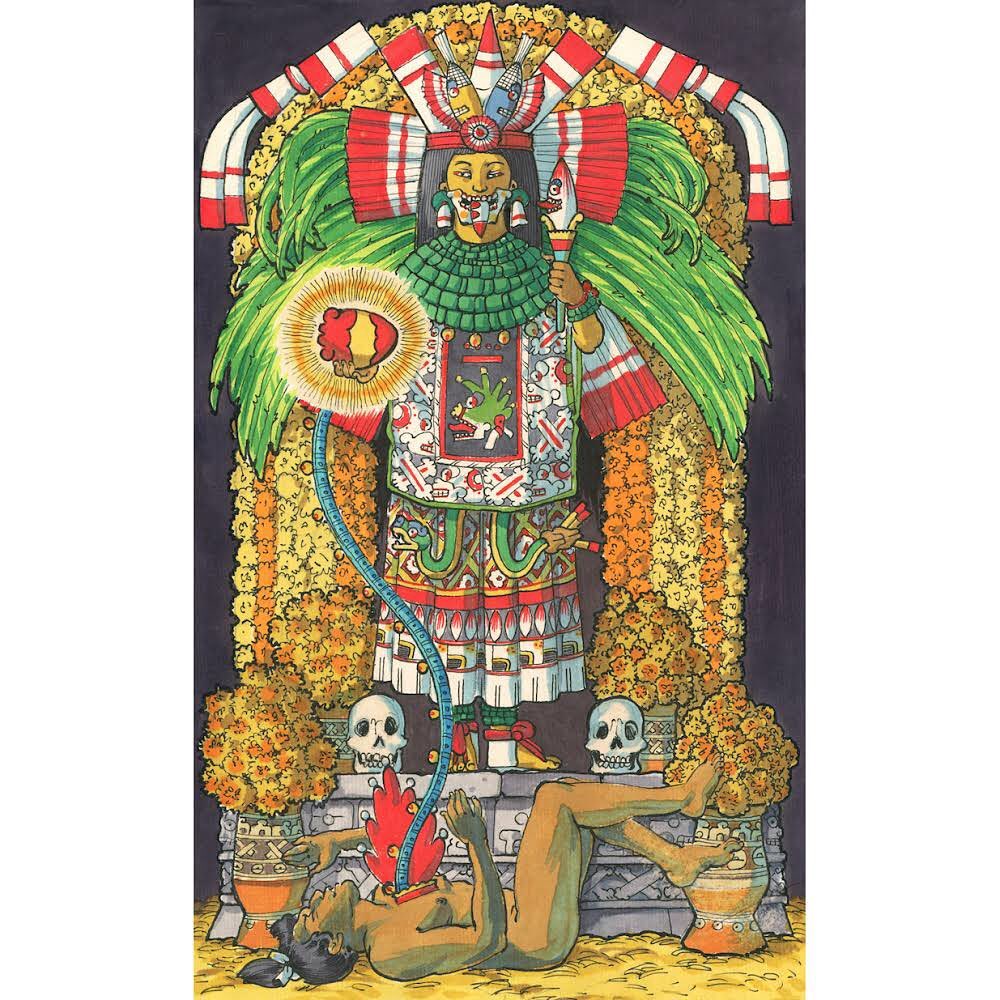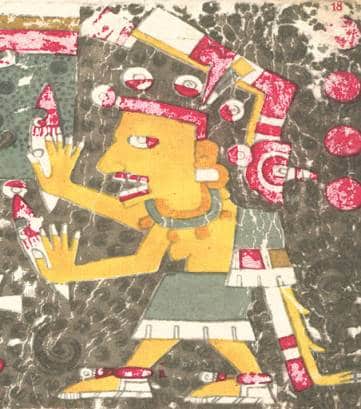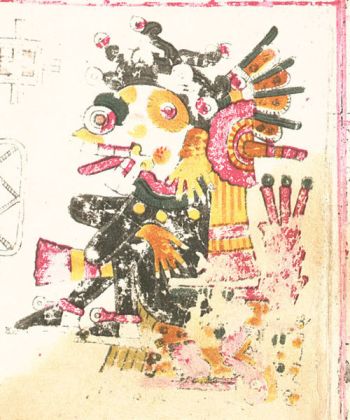Are you a big fan of Halloween and can’t wait for the end of October to dress up in some interesting costumes? Maybe you like to spend this holiday decorating your home with spooky ornaments, or you prefer watching horror movies?
But do you know the origins of Halloween? This holiday originated from All Hallows day, nowadays known as All Saints day, which falls on 1st November each year, just one day after Halloween. All Hallows day is actually borrowed from old Celtic traditions, which later got intermixed with Christianity.
However, we can also trace back some aspects of Halloween to old Mesoamerican cultures, particularly Aztecs. They worshiped many gods and goddesses, and one of those goddesses was Mictecacihuatl, a goddess of the dead.
How did Mictecacihuatl influence the Halloween celebration? What was her role in the Aztec pantheon? Which concepts of Female Divine does she symbolize? Learn all of that and a bit more by reading this article!
Origin Story
Most gods and goddesses are born to other gods and hence start their lives as already powerful deities. Still, some gods and goddesses have humble beginnings, as they are born as humans that “earn” their powers and immortality in various ways, for example, through heroic and selfless deeds.
Mictēcacihuātl belongs to the second group of gods that were humans before they became gods. However, she became a goddess through tragedy and cruelty: she was sacrificed as an infant to the unnamed gods.
As such, Mictēcacihuātl was appointed to become a goddess of the dead, along with her husband, the god Mictlantecuhtli. Together, the couple ruled over the underworld, called Mictlán in Aztec mythology.
Mictlán
To further understand Mictēcacihuātl and her husband’s responsibilities as the rulers of the underworld, let’s take a look at how Mictlán was structured and how it functioned. Mictlán had nine levels that each soul had to travel.
The journey was long and exhausting, and it took four years for each soul to reach the ninth level. While on their journey, the souls had to pass several extreme challenges, such as swimming across a bloodied river filled with jaguars.
Nine Levels of Mictlán
Similar to Dante’s Inferno, the Aztec underworld had nine levels. Each one of these levels had specific sets of dangers and obstacles that made it hard for a soul to pass them. It makes no wonder that it took four years to pass all nine levels!
The first level required the souls to pass the Apanohuaia river, which could only be crossed with the help of Xoloitzcuintle, a dog of white or vermillion color. The second level required the souls to pass between the hills. However, the hills would often get together, and the souls had to wait a long time for the hills to separate before they could continue their journey.
In the third stage, souls had to cross a path of obsidian. At the next level, souls had to go through a place covered in snow while a spirit reminded them of their saddest moments. To pass this level, souls had to let all of their sadness go.
In the fifth stage, souls arrive at a place with such strong winds that some souls can’t overcome it, and they get swept away. At the next level, an invisible hand throws arrows at souls, and souls must avoid them to pass. Each arrow represents one person from the soul’s life.
In the seventh stage, souls swim across the bloodied river, where jaguars wait for them to abandon anything worldly that they might still be carrying with them. In the eighth stage, souls watch their life pass.
When the soul finally reaches the ninth level, it meets with Mictēcacihuātl and Mictlantecuhtli. After that, the soul is finally allowed to enjoy its eternal rest.
Alternative Destinations
However, Mictlán wasn’t the only destination for human souls. Depending on how they died, souls could also be sent to other destinations. For example, people who drowned or died from lightning, or anything related to rain and water, went to Tlalocan.
Warriors who died in the battle or people who died as a sacrifice went east, where they followed the sun in the morning. On the other hand, women who died in childbirth went west, where they accompanied the sun in the evening.
Mictēcacihuātl and Mictlantecuhtli were responsible for making sure that each soul reached the appropriate destination as its place of eternal rest.
Mictecacihuatl’s Role In Death and Rebirth
However, allowing the souls to go to their place of eternal rest wasn’t the only role of Mictēcacihuātl and Mictlantecuhtli. Just like many other cultures, Aztecs believed that death and rebirth were closely connected and vital parts of the circle of life.
This is why Mictēcacihuātl and Mictlantecuhtli were also employed by Quetzalcoatl, the Aztec god of sun and wind, to collect the bones of the dead and give them to Quetzalcoatl. Quetzalcoatl would later use those bones to create new races of mortals.
Quetzalcoatl’s Struggle With Gods of The Underworld
Of course, gods can sometimes be mischievous, and such was the case with Mictēcacihuātl and Mictlantecuhtli trying to sabotage Quetzalcoatl. In one version of the story, Quetzalcoatl went down into the Underworld to collect the bones of the gods that ruled before him.
In one version of the story, Quetzalcoatl tried to steal the bones, which angered Mictēcacihuātl and Mictlantecuhtli. After all, the underworld was their domain of rule, and stealing something from there was the same as stealing from them.
That’s why Mictlantecuhtli blocked Quetzalcoatl’s passage and forced Quetzalcoatl to drop the bones. Still, Quetzalcoatl later managed to gather the scattered bones and take them to the world of the living, where he used them to create many different races.
In another version of the story, Mictlantecuhtli created a deep pit where Quetzalcoatl fell while carrying the stolen bones. The bones shatter into million pieces, and Quetzalcoatl dies.
However, Quetzalcoatl miraculously revives, and he takes the bones with him after all. Since the bones were broken into many pieces of different sizes, Quetzalcoatl created mortals in different sizes too.
Mictecacihuatl’s Appearance

Mictecacihuatl was often depicted as a woman with flayed skin and a gaping skeletal jaw. With her jaw, Mictecacihuatl could swallow the stars before dawn, so that they can’t be seen during the day.
Mictecacihuatl and Santa Muerte
If you are at least a little bit familiar with Mexican culture, you have heard about Santa Muerte. Her name means “Holy Death” because Santa Muerte is the personification of death. Her role is to deliver the sound of her devotees to the afterlife, but she is often invoked to grant healing and protection.
After the Spanish conquered the Aztecs and brought Catholicism with them, the new religion was forced upon the conquered people, and it slowly started pushing out the old beliefs. However, as usually happens in these situations, old traditions survive by mixing with new ones.
Conquered Aztecs and their descendants stopped openly venerating their old gods, but they continued doing it in secret. For example, they continued worshiping Mictecacihuatl in secrecy through various rituals. One such ritual included making a skeletal figure, tying it, and threatening it with lash if it didn’t grant wishes.
Mictecacihuatl morphed into Santa Muerte
Gradually, Mictecacihuatl evolved into Santa Muerte. Her clandestine worship continued up until the 20th century when the celebration of Santa Muerte became more public. Over the last few decades, the veneration of Santa Muerte became more socially acceptable, and today it is considered one of the national symbols of Mexico.
Through Santa Muerte, Mictecacihuatl “survived” the colonization and the almost certain erasure. Her role increased, and she became not only the ruler of the underworld but also the protector and guardian of those who worship her.
It is worth noting that Santa Muerte didn’t evolve from Mictecacihuatl only, as she was influenced by two other Aztec goddesses, La Parca and Cōātlīcue.
Day of The Dead
When speaking about the ties between Mictecacihuatl and Santa Muerte, it is impossible not to mention the Day of the Dead, also known as Día de Muertos. This is a holiday during which Mexicans celebrate their deceased loved ones.
Of course, such holidays exist in other cultures, for example, in various European cultures and countries. However, while the European holidays related to remembering the dead are solemn, Día de Muertos includes singing, dancing, and other activities that are more appropriate for celebrating than for mourning.
During Día de Muertos, families build altars on which they lay their favorite foods and beverages, as well as photos and memorabilia of the deceased persons. By doing this, they hope to attract the souls of the deceased and to have their wishes granted.
Ancient religious traditions became Halloween
Expectantly, the Mexican diaspora, especially in the US, brought this tradition to their new places of living. There, the Día de Muertos traditions further intermingled with the traditions of the descendants of Irish immigrants. This unique mixture created Halloween, one of the most popular holidays in the US.
However, along with other aspects of American culture, Halloween is steadily spreading to other continents. Nowadays, people all over the world are also celebrating Halloween, and by associating, they are paying tribute to Mictecacihuatl.
Mictecacihuatl and Christianity
During the conquest of the Mesoamerican region by Spanish conquistadors, many native deities were syncretized with Catholic saints. Usually, there were some similarities between the native deities and Catholic saints that allowed them to be syncretized.
However, since worshiping death by Aztecs had no counterpart in Catholicism, Mictecacihuatl was never syncretized with any Catholic saints.
Legacy
The relationship with death is an important aspect of every culture. Oftentimes, death is personified by a goddess, and this goddess is usually responsible for much more than just bringing death and ruling over the dead.
Mictecacihuatl is one of those goddesses. Apart from ruling the underworld and making sure the dead arrived at their designated destinations, she also helped create new races of mortals by collecting the bones for Quetzalcoatl.
As the Aztec Empire collapsed under the Spanish attacks, and the descendants of once powerful Aztecs were forcefully integrated into the Spanish Empire, Mictecacihuatl provided them with comfort and protection and helped them keep their traditions alive.
Mictecacihuatl teaches us that there is no life without death and that death shouldn’t be feared. Instead, we should embrace its imminence as a consolation that one day, all our problems will become irrelevant. When we die, our souls will rest for all eternity, away from all worldly problems and worries.
However, even though there was no hell in Aztec religion, the souls couldn’t reach their eternal rest without passing through various challenges, and it took four years to finish all of these challenges.
Although this belief is related to the afterlife, it can be applied to the world of living as well. It teaches us that, to reach a place of comfort and happiness, we must overcome obstacles and challenges until we become wiser, stronger, and worthy.
To truly enjoy the fruits of our labor and our life in general, we need to learn how to let go of the things from our past. As long as we cling on to our past, we will never truly be at peace with ourselves.
Symbols
As a goddess of death and the ruler of the underworld, Mictecacihuatl is often symbolized by things that are associated with death and dying. However, Mictecacihuatl isn’t responsible for deaths that occur; she just embraces the souls and takes them to the afterlife. That’s why she shouldn’t be represented with any symbols of violence and destruction.
General
As Mictecacihuatl was ruling the underworld and collecting bones for other mortals to be created, one of her most common symbols was bones. Bones represent death, but they also represent strength and growth, concepts that can be associated with Mictecacihuatl.
Her other symbols are burning incense, the moon, and cemeteries.
Animals
Jaguars are often mentioned in Aztec mythology, and Aztecs even considered jaguars as kings of all animals. Since jaguars often appear in the stories of the underworld, they are symbols of Mictecacihuatl and her husband.
Other animals that symbolize Mictecacihuatl are the animals that are often associated with death, such as owls, snakes, spiders, and even cats.
Plants
Cempohualxochitl, also named Aztec/Mexican marigold, was often used as a medicine and in the funeral rites of old Aztecs. This is why this flower symbolizes the goddess of death, Mictecacihuatl.
Red or white roses are another symbol of Mictecacihuatl, and they became especially prominent as the symbol of Santa Muerte. Apart from roses and marigolds, any other flowers can be used to symbolize Mictecacihuatl.
Perfumes/Scents
When it comes to perfumes and scents that could symbolize Mictecacihuatl, you should look for scents that are heavy yet intoxicating. Musk, marigold, ginger, sweet davana, rose, labdanum, and tobacco.
Gems and Metals
Gems and metals that symbolize Mictecacihuatl are gold, agate, amethyst, pearls, pyrite, amazonite, rose quartz, and a tiger’s eye. However, it is worth noting that if you plan on building an altar for Mictecacihuatl, you can adorn it with any gems and metals as long as you do it out of your heart.
Goddess Jewelry
There are many reasons why you might want to keep a healing crystal or stone close to you. Getting closer to your goddess by wearing her color or crystal is a great one. That they also look great as jewelry only makes it so much better!
Here is a guide to crystal jewelry you hopefully will find helpful. In it is a list of 30+ crystals and links to some really great looking jewelry with that crystal or stone. Enjoy!
Colors
As the goddess of the dead, Mictecacihuatl can often be seen depicted with black, white, and red. You can also see her surrounded by other colors, especially yellow, orange, green, purple, and blue.
Meditations
- Mictecacihuatl, help me accept my losses and deal with them in a healthy manner.
- Protect me in my darkest hour and give me strength to overcome obstacles in my way.
- Teach me how to leave my past behind in order to enjoy my present and the future.
- Mictecacihuatl, give me the strength to sacrifice what needs to be sacrificed to achieve my goals and reach my full potential.
- Allow me to connect with the loved ones that are no longer with me and help them guide me through life and its challenges.
- Give me the strength to be proud and resilient as my ancestors who fought against the invaders.
- Help me appreciate my origins and my roots, and help me embrace my culture while showing respect to other cultures.
- Mictecacihuatl, send me the challenges that will help me grow as a person, and don’t let me fail or give up.
- Provide me with rest and comfort when I need them, and offer me strength and energy when it is time to get into action.
- Erase my fear of dying and teach me how to live my life properly.
- From the bones of my past mistakes, help me create a future life.
- Protect my loved ones, and don’t take them away too soon.
Want To Bring More Mictecacihuatl Qualities Into Your Life?
- Just like you work on your body, work on your mind and soul too. Think of your past: is there anything that’s still bothering you? Are you still stuck in the past and unable to let go? Learn how to leave the past where it belongs – behind you.
- Has someone insulted, hurt, or betrayed you in the past? Learn how to forgive them in order to let go of your anger and sadness. Only then will you feel free and truly happy.
- Don’t forget to appreciate the good things that happened in your past. Take a look at old photographs, get in contact with old friends, and visit your favorite place from childhood.
- If you lost a close person, light a candle for them. Pray to Mictecacihuatl to grant them easy and safe passage to their final destination. Celebrate their lives by living yours to the full.
- Visit the graveyard and bring flowers. Take a look at other graves, too. Learn more about the lives of the people that are buried there. No one truly dies as long as they are present in the minds of living people.
- Plant a seed. Bury it into the ground and watch it sprout into a new life. Just like that seed, people get buried and make a place for new life. Learn to appreciate this cycle of life, and you will be more capable of accepting death.
- Celebrate the Day of the Dead. If you are of Mexican descent, your relatives can certainly help you celebrate this holiday. However, if you aren’t of Mexican descent, you can still celebrate as long as you are respectful and willing to learn. Mictecacihuatl accepts anyone who has an open mind and a pure heart.
Other Goddesses
If you enjoyed this post we are sure you will enjoy getting to know some of the other goddesses we also write about. You can find the complete list of goddesses sorted across regions and religions here.
Featured Image Credit: Mictēcacihuātl




